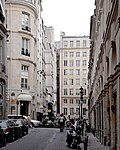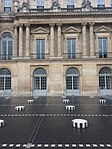Galerie de Montpensier
Streets in the 1st arrondissement of ParisÎle-de-France geography stubs

The Galerie de Montpensier is a gallery in the Palais-Royal in the 1st arrondissement of Paris, France.
Excerpt from the Wikipedia article Galerie de Montpensier (License: CC BY-SA 3.0, Authors, Images).Galerie de Montpensier
Rue de Valois, Paris 1st Arrondissement (Paris)
Geographical coordinates (GPS) Address Nearby Places Show on map
Geographical coordinates (GPS)
| Latitude | Longitude |
|---|---|
| N 48.865435 ° | E 2.337416 ° |
Address
Jardin du Palais Royal
Rue de Valois
75001 Paris, 1st Arrondissement (Paris)
Ile-de-France, France
Open on Google Maps











